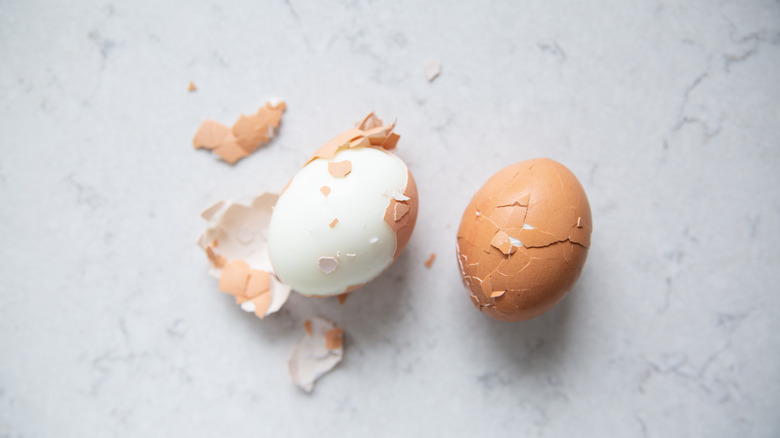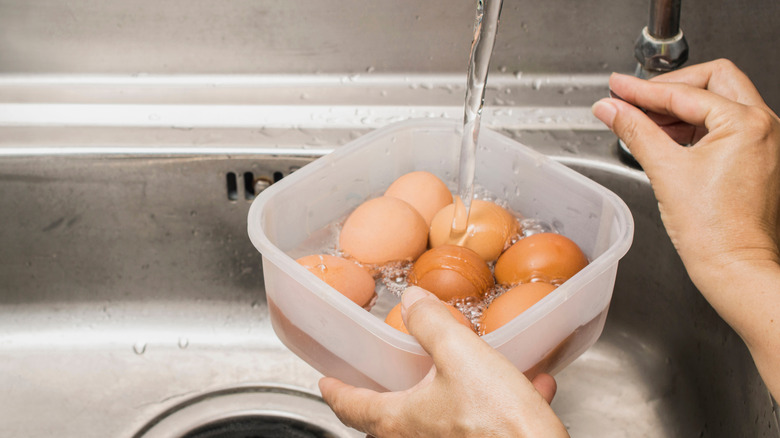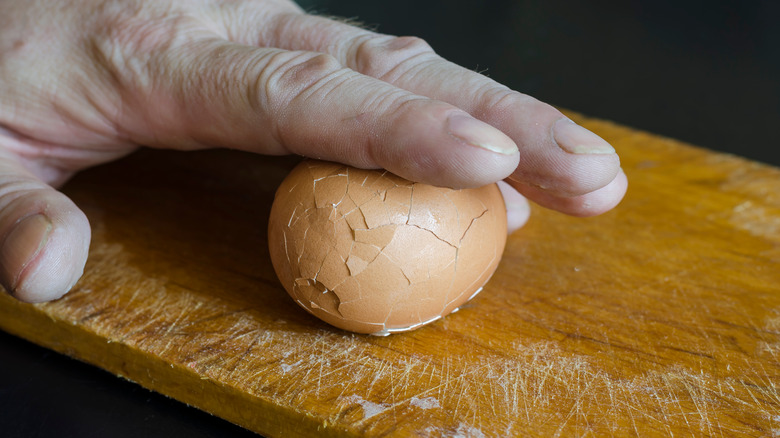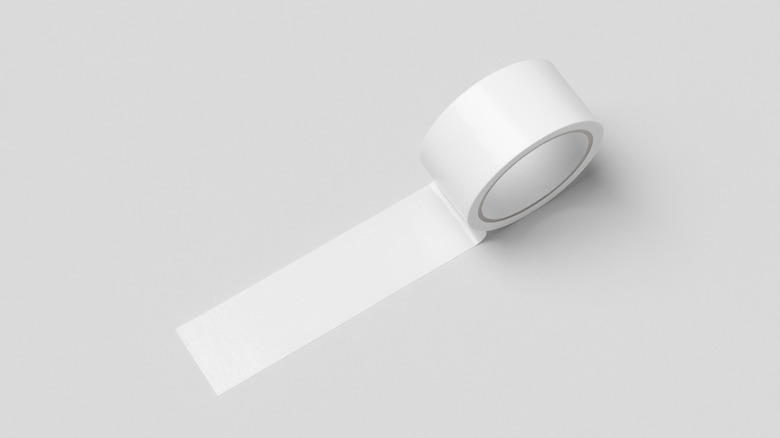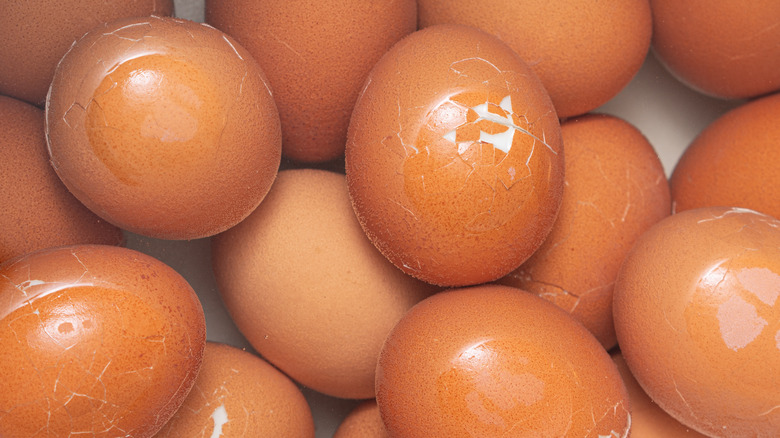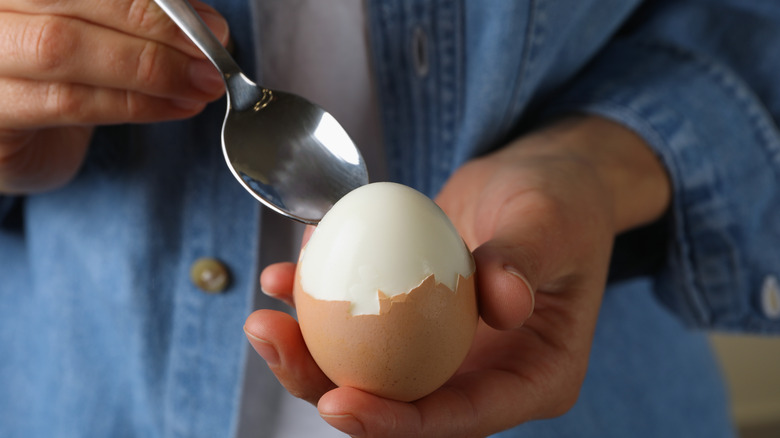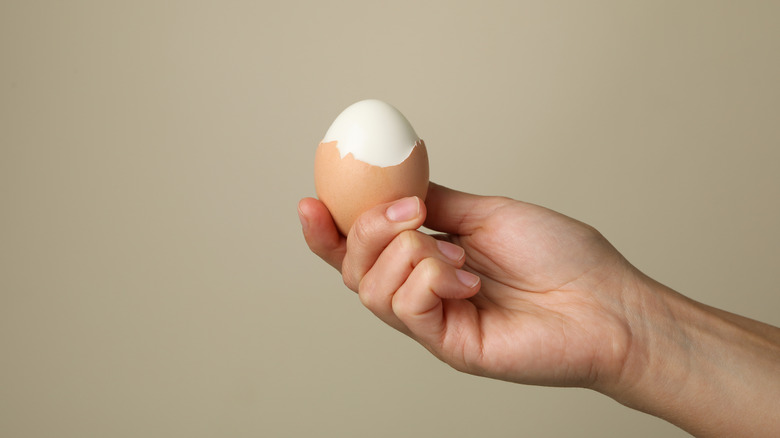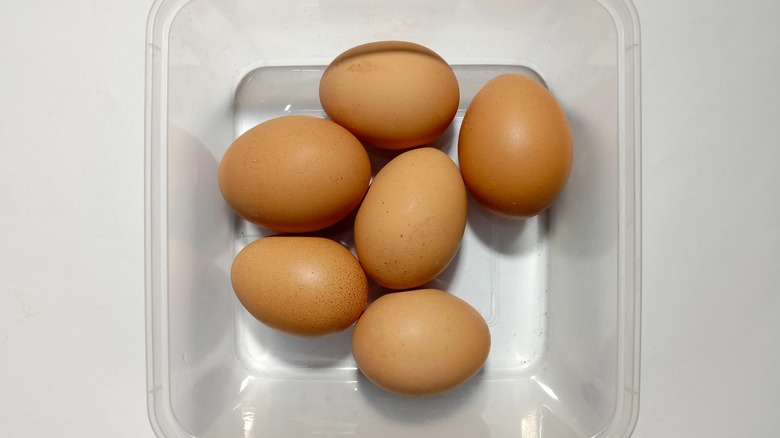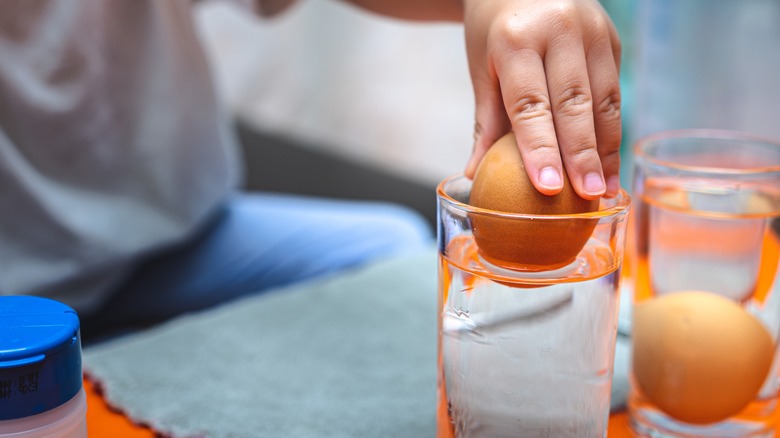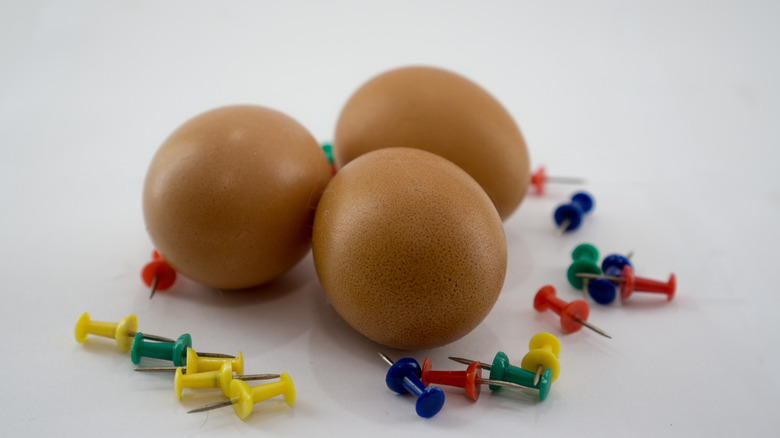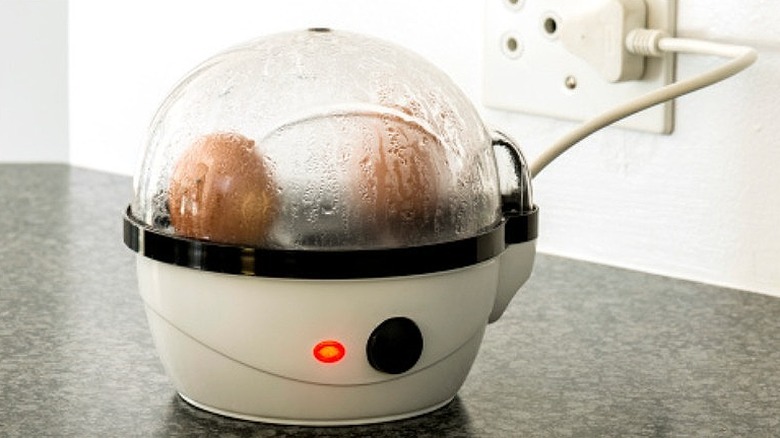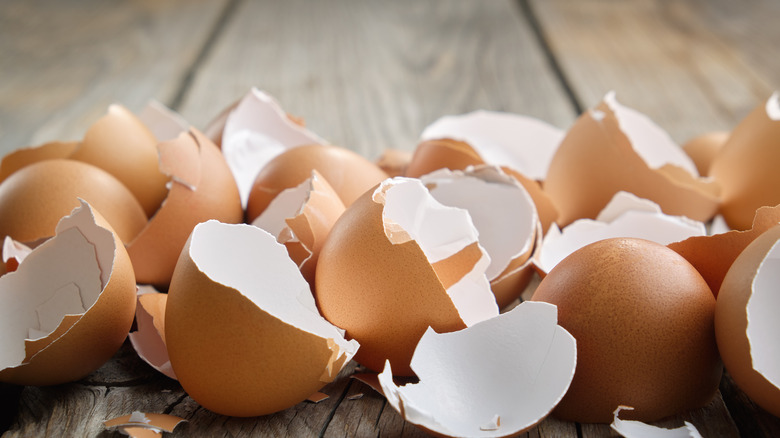12 Ways To Easily Peel Hard-Boiled Eggs
We may receive a commission on purchases made from links.
Boiled eggs are fantastic, whether you enjoy them in a Cobb salad, as a post-workout snack, or in an egg sandwich. The process of cooking hard-boiled eggs is relatively simple, but the aftermath (otherwise known as peeling them) makes some people dread making them.
The reality is, there are a number of factors that make some eggs harder to peel than others. For example, if you use fresh eggs rather than week-old ones, the low pH level makes the shells stick to the whites more. Additionally, if you try to peel eggs while they're still hot, you'll have more trouble than if you chill them in an ice bath. As a matter of fact, trying to peel eggs prematurely is one of the biggest mistakes people make with eggs. But even if you follow the recommended steps, it's still possible to end up with a mess on your hands.
Luckily, there are several hacks when it comes to de-shelling eggs, so you don't have to sit around peeling off itty-bitty pieces as you slowly lose your cool. These tricks make the peeling process a breeze — so much so that the prep work may become as enjoyable as eating the eggs themselves.
Peel them under water
If you want to know how to peel hard-boiled eggs perfectly every time, we've got the scoop: Simply peel them under water. There is more than one way to do this — you can use running water or standing water. If you plan to use running water, turn on your sink and place a bowl under the flow to catch the egg in case you accidentally drop it. Crack the egg and begin to peel away the shell. The water works with you because the liquid gets in between the shell and the white while you peel it.
Another way to use water to your advantage? As soon as you boil the eggs, remove the hot water from the pan you cooked them in and substitute it with cold water. Give the eggs a few minutes to rest in the water and cool. Once they're at roughly room temperature, start to peel them beneath the liquid. You'll find the shells easily detach from the whites — how neat is that?
Roll the egg on the countertop to break the shell
A common trick you should try if you haven't: Roll the cooked eggs on your countertop to break up the shell and make it easier to peel. More specifically, put the palm of your hand on the egg and lightly press on it while you move it around. As you do, the fragile shell breaks into many small pieces. Be careful not to apply too much pressure or you'll smash the egg along with the casing, which you surely don't want. Once you roll the egg back and forth a few times, you can go ahead and peel it.
This technique makes the broken shell pieces small enough that egg chunks won't peel away with them, leaving the egg looking lumpy and unappetizing. You can also combine this technique with the underwater method to remove the shell without leaving little bits and pieces of shell behind.
Use the tape method
Have you ever heard of the tape method? If you have a roll of packing tape sitting around your house, now is the time to put it to good use. This might not be the ideal method for you if you plan to make a jumbo batch of hard-boiled eggs. However, this approach is a lifesaver if you only have a handful of eggs. Can tape really peel an egg, you ask? The answer is yes. First, take each egg and individually wrap its exterior with a strip of tape. You don't need to place tape on the short ends of the eggs; a single strip around the midline will do.
Next, using both hands, roll the egg a few times, and crack the shell by applying light pressure. Finally, remove the tape you placed around the egg and the broken shell impressively follows suit. There might be some residual pieces, especially on the ends, but all you need to do is pull them off.
Follow Gordon Ramsay's process
Seeing as Gordon Ramsay has tricks for all sorts of cooking methods, it is no surprise that Ramsay has a foolproof process for perfectly peeling boiled eggs. To try out his approach, the famous chef suggests you first add cold water to your pot of just-cooked eggs. Alternatively, you can transfer them to a bowl that contains cold water. Wait a bit before handling the eggs, giving them a chance to cool down. Otherwise, they'll be too hot to work with.
Take an egg at a time (or two if you're bold) and gently crack them on the bowl's rim. Avoid making the mistake of splitting the egg so hard that you slice into the white. Next, return the eggs to the water and let the water do the work for you. The liquid gradually works its way to the membrane of the egg through the cracks. As a result, the shells begin to loosen, providing you with a pain-free manner to remove them and use the eggs how you want.
Use the spoon method
It's no secret that spoons come in handy in the kitchen, and they even lend a helping hand in one of the best hard-boiled egg hacks you can find. If you use a spoon to take the skin off kiwis or scoop the pulp out of avocados, this method will be as easy as pie as it basically uses the same methodology. First, crack one of the short ends of the egg and manually pull away some of the casing. The opening should be large enough for a spoon to fit within.
Next, grab your spoon and carefully place it in the thin gap between the shell and the white. Finally, turn the spoon and the egg, rotating it like a globe until you've successfully de-shelled it. It's worth noting you shouldn't do this with a warm egg; it works better with eggs you've placed in an ice bath or, at the very least, in cold water. You can experiment with different types and sizes of spoons, too — some produce better results than others.
Crack the ends of the shell and use air to dislodge the egg
This hard-boiled egg peeling technique stunned the internet when it first started going viral in 2020 because it was unconventional and successful. In short, you have to blow on the exposed end of a slightly cracked egg to release it from the shell. A word of advice: Use this hack for eggs you're going to consume yourself. It isn't the most sanitary approach if you plan to cook for a crowd.
To try it out, strip the shell off the top and bottom of the egg (it has to be a hole big enough for the egg to fly through). Next, set up a bowl or safe landing spot for the egg if you fail to catch it. Use one hand to hold the sides of the egg and blow air into the smaller end of it until you dislodge the egg through the other side. Use your other hand to catch the egg.
If you find this trick doesn't work for you, you might've accidentally left the thin membrane intact when you peeled the ends. This makes it a lot more difficult for the egg to pass through. While this technique takes practice to perfect, once you get it down, it's pretty effective and swift.
Shake them in a container
If you're interested in learning how to peel a dozen hard-boiled eggs at once, look no further. This clever procedure requires no special equipment, just a bit of elbow grease. The first approach is to shake the eggs in the pot you cooked them in. Empty the water from the pot, then shake the whole thing back and forth repeatedly so the eggs crack against the sides (and each other) with a little force. While some shells might come completely off, the others will be broken into small enough pieces to pull away quickly and cleanly.
Another way to do this is to shake the eggs in a bowl after refrigerating or cooling them in an ice bath. Move them to a glass or plastic container and follow the previous procedures to crack the shells. You may find the shells come off even easier this way since the cooled eggs have likely already eased away some from the shells.
Use a glass of water to break the shell
This method is similar to the shaking process because it requires you to agitate the egg; however, with this method, you do it underwater. Amazingly, the water glass method effortlessly peels eggs, so much so that it removes the shells for you. Just grab a plain ol' glass or a Mason jar. To use a cup, carefully drop the egg inside and cover it in water. Then, use one of your hands to cover the opening. Hold it tightly to prevent water from splashing (or do this over the sink to prevent a mess), and shake the glass until the shell cracks and peels away.
This method is even easier if you have a lidded jar. TikTok user, @rominagafur, demonstrates how to do so in an impressive video. To try it yourself, follow the same steps as if you were using a lid-free glass, except this time, secure the lid before you rattle the jar. In almost no time the shell should entirely detach from the egg, leaving the egg ready to eat.
Try the thumbtack trick
If there's one thing you shouldn't doubt, it's the wide-ranging talents of a push pin. While these typically reside with your office supplies, it's time to track one down because thumbtacks make boiled eggs easier to peel. To take a stab at this method, you need to do a little prep work before you cook your eggs. Take the thumbtack and gently prick the large end of the egg to create a microscopic opening. Don't push too hard or try to puncture it multiple times. Once is enough.
Cook the eggs as usual. While it might feel odd to submerge the eggs in water with a hole, don't fret — you won't lose any of the whites or yolks in the cooking process. Once you boil the eggs, cool them before you peel them. You'll be pleasantly surprised how trouble-free it is to strip the shell off with your hands.
Cut the egg in half with the peel intact, then scoop out the egg
Have you ever thought to slice straight through the egg with the casing still on? Although it's outlandish to some folks, it works surprisingly well. First, place the egg on its side and grip it with one hand. Next, use a serrated knife to cut straight down through the shell. Don't let go of the egg as you cut because the egg and knife will turn and slip, creating a potential safety hazard. From here, you have two egg halves. Use a spoon to pop out each half, then repeat the process for all your eggs.
If you don't want to use a spoon, you can use your fingers to separate the white and the shell. Of course, this trick isn't for folks who need their boiled eggs to remain whole. But if you aim to use them right away, you may suddenly feel like you've been peeling eggs wrong your whole life.
Steam the eggs to separate the membrane and whites
To peel hard-boiled eggs in record time, steam them instead of boiling them. Use an electric food steamer or the steam setting on an Instant Pot for a smooth experience. Alternatively, if you don't own special equipment, set up a pot of water and a steamer basket. Line the basket with a single layer of eggs. It's not wise to create a pile of eggs in the basket because they may cook unevenly if the steam can't access all of them equally.
To ensure the yolks turn hard rather than soft, cook them for upwards of 10 minutes — 12 minutes should be the sweet spot. When you steam the eggs, you create some distance between the whites and the membrane. This prevents the shells from adhering to the eggs as they commonly do. It makes all the difference when it comes time to peel the shell away.
Use egg-peeling gadgets
When all else fails, you can always invest in egg-peeling gadgets to make your life easier. Did you know there are numerous tools that companies specially design for this reason? In a YouTube video uploaded by CrazyRussianHacker, the influencer demonstrates how to use seven different gadgets. One example is a contraption that you put the egg inside of and shake to remove the peel, similar to the glass of water technique.
There is another double-ended tool that cuts the shell and helps you to pop it off. Although you can replicate many of these tools with items you already have at home, one specific gadget stands out from the rest. It is called the Eggstractor (see what they did there?), and it uses pressure to separate the egg from the casing. To use it, you put a single egg inside the device (after you crack the bottom edge) and press the accordion-looking apparatus down firmly with both hands. The egg spectacularly pops out of the bottom with no shell on.
One downside is that it doesn't work perfectly every time, and if you're not careful, the device slips. That said, the gadgets are all reasonably successful with a bit of trial and error.
